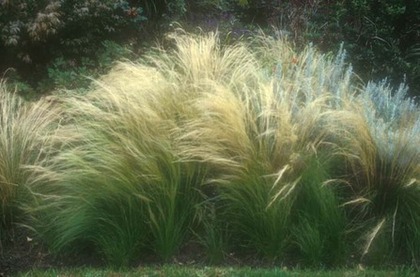
tel: 512 280-1192 Thursday, April 3 2014
Nursery Notes: New shipments of native perennials just arrived:
4" pots, $2.59. 1 gal, $ 7.99. Lots of colorful roses in stock: knock-
outs - $24.99, antiques $19.99, 5 gal blooming Lady Banks roses
$34.99. Annual and perennial flowers for $1.50 to $2.59. For the
monarchs, 4" pots of milkweed - $2.59. Hanging baskets: $14.99
bougainvilleas $19.99.

John Kelso: the Lighter Side of Gardening this Sunday, 2 p.m.
(Free) Humor and horticulture from the award-winning columnist
for the Austin American-Statesman. He will also be signing copies
of his book Confessions of a Professional Smartass kelso
[Next Sun., Susan Wittig Albert, the mystery of herbs, 3 p.m.]
____________________________________________________Trowel & Error, the Mayfield Gardening Symposium, this Sat.
from 9:30 - 1 p.m. Speakers include our very own Amanda Moon
at 10 a.m. who will present some rare heat and drought tolerant
plants. Special performance at 9:30 by Australian poet extraor-
dinaire - Thom the World Poet. trowel & error
____________________________________________________
Need ideas for a patio? From Lonny Magazine come ninety
different designs... something for everybody. Lonny Magazine
_____________________________________________________
Gardening to Save Monarchs: Populations of the world's only
migrating insect are at an all-time low. Some tips from Wildflower
Center director Andrea DeLong-Amaya on how local gardeners
can help them with milkweed and nectar plants. From an article
on the Center's website by Barbra A. Rodriguez. Wildflower Center
_____________________________________________________
Central Texas Gardener: A chat about serious drought tolerant
perennials with Janet Rademacher from the Mountain States Whole-
sale Nursery in Arizona. On tour, a visit with a young San Antonio
family that dumped the lawn for a xeric-style party. Sat. noon,
4 p.m. or Sun., 9 a.m. www.klru

Mexican Feather Grass (Nassella tenuissima) has thread-like leaves that
billow gracefully in the slightest breeze.
Eight Garden Activities for April
by Chris Winslow
1. Spring vegetable gardening Plant those warm season crops.
This list includes beans, black-eyed peas, okra, squash, cantaloupe,
tomatoes, peppers, cucumbers, watermelon, corn, and eggplant.
There is still time to plant cooler season crops like lettuce, radishes,
and carrots.
2. Fertilize your garden Do this organically with compost. Other
sources of nutrition are dried fish flakes and organic fertilizers form-
ulated for garden use. You can also use liquid fertilizers, such as
fish emulsion and seaweed extracts.
3.Control weeds Keep them down with mulch and by weeding a
little bit every day.
4. Plant spring annuals This is the perfect time. Work some com-
post into your flower beds and you will give these new plants just
the food they need to flower through the summer. Here are some
ideas: begonias, zinnias, marigolds, petunias, coleus, periwinkle,
cosmos, larkspur, portulaca, and purslane.
5. Plant perennials Choose some of your favorites from the exten-
sive lists available, or visit your neighborhood nursery and browse.
Look for the many varieties of drought tolerant and showy lantanas
and salvias. Also blackfoot daisies, skullcaps, purple coneflowers,
black-eyed Susan, plumbagos, columbines, rockrose, ruella, and
verbena.
6. Ornamental grasses Native varieties are best due to their heat
and drought tolerance. My favorites are big muhley, coastal muhley
and the maiden grasses. For a short grass in a very dry place, you
might like Mexican feather grass. It is blond-colored, reaches 1.5
foot in height, and makes a beautiful accent plant that moves so
gracefully with the slightest breeze.
7. Fertilize lawn Use a slow release organic fertilizer. A 3-1-2 ratio
is best. Allow 10 pounds of fertilizer for every 1,000 square feet of
lawn. Mowing height should be 2.5 inches for St. Augustine grass
and 2 inches for Bermuda and zoysia. I like to return the grass clipp-
ings to the turf. These clippings act as a mulch and help to reduce
weeds. Water infrequently and deeply to encourage a deep root system.
This practice will train your lawn grass to be more drought tolerant
and help to conserve water.
8. Fertilize shrubs, trees Mulch with a compost-mulch blend to
provide nutrients and conserve water. Deep, infrequent watering of
shrubs and trees will encourage deep, drought tolerant root systems.
Remember to seal pruning cuts on oak trees. It might save them from
oak wilt. Happy springtime gardening everyone!
 Visit the website: www.itsaboutthyme.com
Visit the website: www.itsaboutthyme.com Visit the nursery:11726 Manchaca Road, Austin, 78748 Like us
on facebook